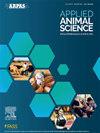Evaluating and improving the pasture factor based on herbage allowance and nutritive value to estimate the daily herbage intake of stockers grazing bermudagrass
IF 1.5
Q3 AGRICULTURE, DAIRY & ANIMAL SCIENCE
引用次数: 0
Abstract
Objective
The critical herbage allowance (cHA), de- fined as the herbage allowance (HA) level below which DMI becomes limiting, is a key variable defining the pas- ture factor used in a daily gain model (DGM) to estimate the daily DMI of stockers grazing bermudagrass (Cynodon dactylon [L.] Pers.) as constrained by HA and nutritive value. Our objective was to evaluate the DGM containing the cHA function using a new, comprehensive database.
Materials and Methods
We evaluated the DGM with its cHA function, using the observed and model-predicted ADG values involving 1,032 stocker calves in 33 grazing trials conducted at Overton, Texas. Based on evaluation results, we then modified the cHA function by incorporat- ing an enhancement factor (κ). By running the DGM with a potential κ value and evaluating it using the ADG data several times iteratively, we derived the best κ value.
Results and Discussion
Evaluation results showed that the DGM containing the original cHA function con- sistently underpredicted ADG, as the function was too restrictive to DMI. This issue indicated that the cHA func- tion needed to be less restrictive. After multiple iterations of DGM running and testing, we derived 0.75 for κ. With the modification of the cHA function through the incor- poration of κ (= 0.75), the DGM performance improved significantly. The modeling efficiency increased by about 31%, the modeling error decreased by about 16%, and the estimated DMI increased from 1.9% BW to 2.1% BW for stockers grazing bermudagrass.
Implications and Applications
By incorporating κ into the cHA function in the DGM, this study addressed the issue of consistent underprediction of ADG. By in- cluding the improved cHA function in an herbage intake prediction system, the DGM users can more accurately explore the effects of various management and environ- mental factors on daily DMI and ADG of stockers grazing bermudagrass.
基于草料补给量和营养价值评价和改进放牧因子,估算放牧者日采食量
目的:在日增重模型(DGM)中,放牧人放牧百慕大草(Cynodon dactylon)的日增重模型(DGM)中,临界供草量(cHA)是决定草场因子的关键变量。[Pers.]),受HA和营养价值的限制。我们的目标是使用一个新的、全面的数据库来评估包含cHA函数的DGM。材料与方法利用在德克萨斯州奥弗顿进行的33次放牧试验中1032头牲畜的平均日增重观测值和模型预测值,对DGM及其cHA功能进行了评估。根据评估结果,我们通过加入增强因子(κ)来修改cHA函数。通过运行具有潜在κ值的DGM,并使用ADG数据进行多次迭代评估,得出最佳κ值。结果与讨论评价结果表明,含有原始cHA功能的DGM始终低于ADG,因为该功能对DMI的限制太大。这个问题表明cHA功能需要减少限制。经过多次DGM运行和测试,我们得出κ值为0.75。通过加入κ(= 0.75)对cHA函数进行修饰,DGM性能显著提高。模拟效率提高约31%,模拟误差降低约16%,放牧者放牧时的DMI由1.9% BW提高到2.1% BW。通过将κ纳入DGM中的cHA功能,本研究解决了ADG一致低估的问题。通过在牧草采食量预测系统中引入改进的cHA功能,DGM用户可以更准确地探索各种管理和环境因素对放牧百慕草的日采食量和平均日增重的影响。
本文章由计算机程序翻译,如有差异,请以英文原文为准。
求助全文
约1分钟内获得全文
求助全文

 求助内容:
求助内容: 应助结果提醒方式:
应助结果提醒方式:


